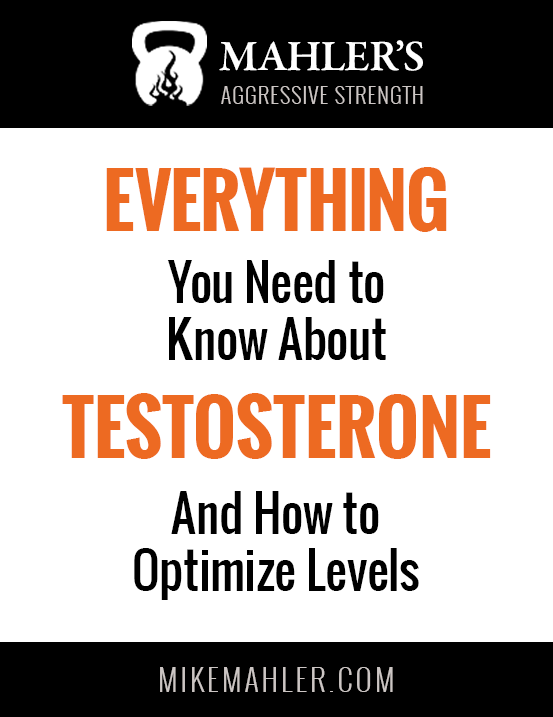By Mike Mahler
In Part 1 of this series, I showed the entertainment-addicted youth of our nation — Generation Ent — how to do hardcore cardio work that’s fun, challenging, highly effective, and never boring.
This time the subject is size and strength. The workout is based on ideas popularized by Louie Simmons, a true strength-training pioneer. The powerlifters Louie trains at Westside Barbell Club are some of the strongest men and women around.
Most young men reading this don’t care about setting squat or bench press records, and I can’t recall the last time I met anyone who told me his goal is to look like a heavyweight powerlifter.
So why would I base this workout on those used by some of the world’s strongest humans? One word: variety. Westside lifters know how to mix things up. They don’t cater to Gen Ent, but their workouts offer enough novelty to keep even the most distractible lifter engaged. As long as you avoid eating like a powerlifter, you’ll develop a strong and solid physique with powerlifters’ training techniques.
Three Workouts, Three Goals
My program includes three total-body workouts each week, each with its own goals and challenges.
Monday: Maximum Size and Strength
At Westside, the lifters work up to a one-rep max on a chosen exercise on maximum-effort day. The following week they max on a similar but different exercise. For example, if they use the floor press one week, they might use the decline press the next. They call this the “conjugate method.”
But while working up to a one-rep max is great for building pure strength, it’s not ideal for hypertrophy. For that, you need more reps. So instead of a 1RM you’ll work up to a five-rep max on the chosen exercise. You’ll still increase your strength, but also induce muscle growth as well. (I picked up this tip from Andrew Durniat, an outstanding strength coach and strongman competitor.)
Another change: Instead of switching your main max-effort exercise each week, you’ll change every three weeks. This way you have a chance to get good at the exercise before moving on. This is a flexible standard; if you’re new to training, you can spend up to six weeks on each max-effort exercise, as long as you keep improving on your 5RM. More advanced trainees, who adapt quickly to their training programs, may want to change every two weeks.
Most of you, however, will do well with this three-week rotation:
Week one: Work up to a weight that’s one rep shy of failure. The goal is to get your fifth rep on your final set feeling as if you could do one more.
Week two: Add five pounds on your final set and go for five reps, even if the fifth rep pushes you to your limit.
Week three: Go all out — the heaviest weight you can use for five reps, even if you risk failure on the fourth or fifth rep. (Just make sure you use a spotter where appropriate.) This is your final week on the exercise, so you really want to push it.
Start over with another exercise the following week, using the same progression.
You’ll do this with four different categories of exercise:
• presses (vertical and horizontal)
• upper-body pulls (vertical and horizontal)
• squats
• lower-body pulls
I’ll provide lists of exercises in each category in a bit.
Wednesday: Repetition Method
One workout a week, you’ll use light weights for timed sets. But don’t mistake “light” for “easy.” An example would be a five-minute set of the dumbbell clean and press, using about 30 percent of your one-rep max.
One goal, says Louie Simmons, is to jack up growth-hormone production, promoting bigger muscles with better body composition. Another goal is to increase strength endurance, helping you train longer and harder. Finally, by putting this workout in the middle of the training week, you’ll get some active recovery from your max-effort workout.
Friday: Speed
Despite what advocates of Super Slow training say, you have to get fast if you want to get strong. Really strong men and women don’t set out to do slow and controlled lifts of really heavy weights.
Sure, the bar may move slowly when you’re lifting maximum weights. But that’s not because you’re trying to lift it at that speed. You’re trying to finish the job as fast as you possibly can, with as much force behind the effort as you can generate. It just happens to move slowly because it’s a really fucking heavy weight.
As our own Chad Waterbury says, muscles are meant to contract quickly. All of the recent focus on prescribed rep speeds has set strength training back dramatically.
Faster muscles aren’t just for performance. The muscle fibers responsible for fast, high-effort movement are also the ones that have the most potential to get bigger. Fast training also has powerful effects on your body comp — you’ll jack up your metabolism in the short term and, over time, keep it up and running at a chronically higher rate.
Finally, lifting fast is just more fun than lifting slow. You’ll feel ramped up after your workouts, rather than wiped out.
Word of caution: You still have to use good form. Sloppy lifts are a bad idea at any speed, and they’re especially bad when you’re moving the weight as fast as possible.

